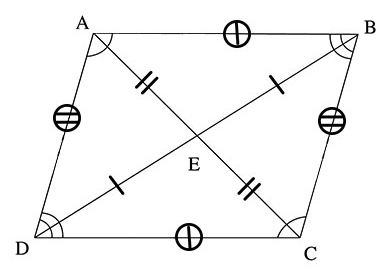Properties of a Parallelogram Lesson
The Six Main Properties of a Parallelogram
A parallelogram is a quadrilateral with two pairs of parallel sides. The six main properties of a parallelogram are given as:
- Opposite sides are parallel.
- Opposite sides are congruent.
- Opposite angles are congruent.
- The diagonals bisect each other.
- Adjacent angles are supplementary (meaning their sum is 180°).
- If one angle is 90°, then all angles are 90°.

INTRODUCING

Examples of the Properties Being Applied
Let's go through an example where we apply the 6 properties to parallelogram ABCD above.
- Opposite sides are parallel.
Side AB is parallel to side DC.
Side AD is parallel to side BC. - Opposite sides are congruent.
Side AB is equal in length to side DC.
Side AD is equal in length to side BC. - Opposite angles are congruent.
∠A = ∠C
∠B = ∠D - The diagonals bisect each other.
Diagonal AC passes through the center of diagonal BD.
Diagonal BD passes through the center of diagonal AC. - Adjacent angles are supplementary (meaning their sum is 180°).
∠A + ∠B = 180°
∠B + ∠C = 180°
∠C + ∠D = 180°
∠D + ∠A = 180° - If one angle is 90°, then all angles are 90°.
If ∠A = 90°, then ∠B, ∠C, and ∠D are also 90°.

